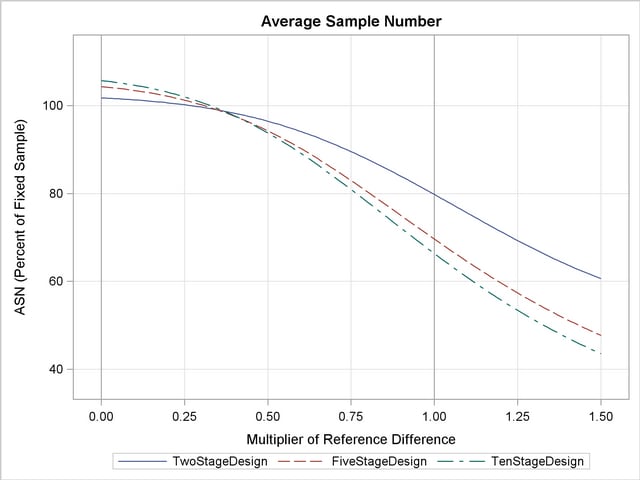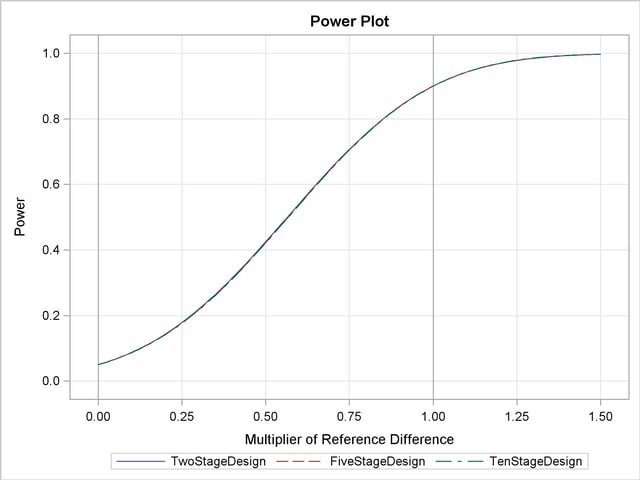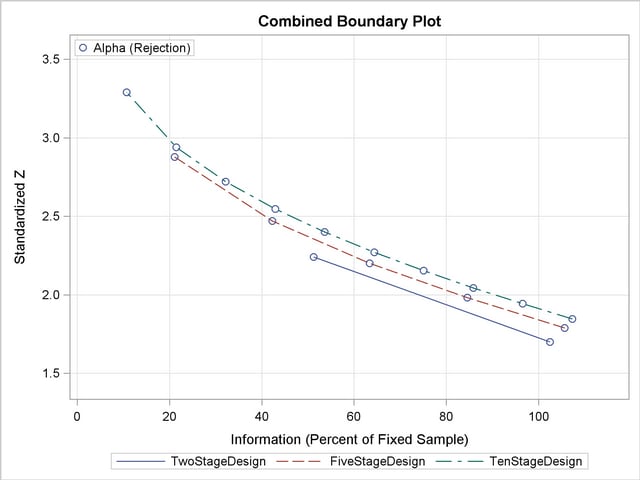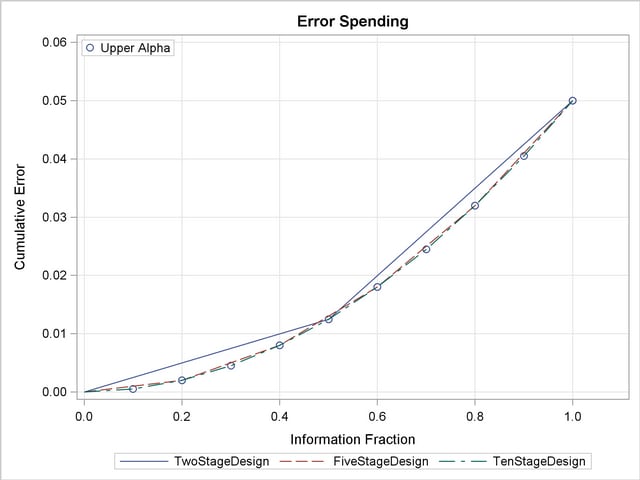| The SEQDESIGN Procedure |
Example 77.9 Creating Designs with Various Number of Stages
This example requests three group sequential designs for normally distributed statistics. Each design uses the power family error spending function with the default power parameter  . The specified error spending method is between the approximated Pocock method (
. The specified error spending method is between the approximated Pocock method ( ) and the approximated O’Brien-Fleming method (
) and the approximated O’Brien-Fleming method ( ) (Jennison and Turnbull 1999, p. 148). The three designs are identical except for the specified number of stages. The following statements request the group sequential design with the default standardized
) (Jennison and Turnbull 1999, p. 148). The three designs are identical except for the specified number of stages. The following statements request the group sequential design with the default standardized  scale for the boundary values:
scale for the boundary values:
ods graphics on;
proc seqdesign plots=( asn
power
combinedboundary
errspend(hscale=info)
)
;
TwoStageDesign: design nstages=2
method=errfuncpow
alt=upper stop=reject
;
FiveStageDesign: design nstages=5
method=errfuncpow
alt=upper stop=reject
;
TenStageDesign: design nstages=10
method=errfuncpow
alt=upper stop=reject
;
run;
ods graphics off;
The "Design Information" table in Output 77.9.1 displays design information for the two-stage design.
| Design Information | |
|---|---|
| Statistic Distribution | Normal |
| Boundary Scale | Standardized Z |
| Alternative Hypothesis | Upper |
| Early Stop | Reject Null |
| Method | Error Spending |
| Boundary Key | Both |
| Number of Stages | 2 |
| Alpha | 0.05 |
| Beta | 0.1 |
| Power | 0.9 |
| Max Information (Percent of Fixed Sample) | 102.4167 |
| Null Ref ASN (Percent of Fixed Sample) | 101.7766 |
| Alt Ref ASN (Percent of Fixed Sample) | 79.81021 |
The "Boundary Information" table in Output 77.9.2 displays the information level, alternative reference, and boundary values with the default standardized normal  scale. The resulting standardized alternative reference at stage
scale. The resulting standardized alternative reference at stage  is given by
is given by  , where
, where  is the alternative reference and
is the alternative reference and  is the information level at stage
is the information level at stage  ,
,  .
.
 Scale
Scale
The "Design Information" table in Output 77.9.3 displays design information for the five-stage design. Compared with the two-stage design in Output 77.9.1, the maximum information increases from  to
to  , and the average sample number under the alternative reference (Alt Ref ASN) decreases from
, and the average sample number under the alternative reference (Alt Ref ASN) decreases from  to
to  .
.
| Design Information | |
|---|---|
| Statistic Distribution | Normal |
| Boundary Scale | Standardized Z |
| Alternative Hypothesis | Upper |
| Early Stop | Reject Null |
| Method | Error Spending |
| Boundary Key | Both |
| Number of Stages | 5 |
| Alpha | 0.05 |
| Beta | 0.1 |
| Power | 0.9 |
| Max Information (Percent of Fixed Sample) | 105.6235 |
| Null Ref ASN (Percent of Fixed Sample) | 104.356 |
| Alt Ref ASN (Percent of Fixed Sample) | 69.64322 |
The "Boundary Information" table in Output 77.9.4 displays the information level, alternative reference, and boundary values with the default standardized normal  scale.
scale.
 Scale
Scale
The "Design Information" table in Output 77.9.5 displays design information for the ten-stage design. Compared with the five-stage design in Output 77.9.3, the maximum information increases further from  to
to  and under the alternative reference, the average sample number decreases further from
and under the alternative reference, the average sample number decreases further from  to
to  .
.
| Design Information | |
|---|---|
| Statistic Distribution | Normal |
| Boundary Scale | Standardized Z |
| Alternative Hypothesis | Upper |
| Early Stop | Reject Null |
| Method | Error Spending |
| Boundary Key | Both |
| Number of Stages | 10 |
| Alpha | 0.05 |
| Beta | 0.1 |
| Power | 0.9 |
| Max Information (Percent of Fixed Sample) | 107.256 |
| Null Ref ASN (Percent of Fixed Sample) | 105.7276 |
| Alt Ref ASN (Percent of Fixed Sample) | 66.35565 |
The "Boundary Information" table in Output 77.9.6 displays the information level, alternative reference, and boundary values with the default standardized normal  scale.
scale.
 Scale
Scale
| Boundary Information (Standardized Z Scale) Null Reference = 0 |
|||
|---|---|---|---|
| _Stage_ | Information Level |
Alternative | Boundary Values |
| Reference | Upper | ||
| Proportion | Upper | Alpha | |
| 1 | 0.1000 | 0.95840 | 3.29053 |
| 2 | 0.2000 | 1.35538 | 2.94037 |
| 3 | 0.3000 | 1.65999 | 2.72115 |
| 4 | 0.4000 | 1.91679 | 2.54808 |
| 5 | 0.5000 | 2.14304 | 2.40114 |
| 6 | 0.6000 | 2.34758 | 2.27127 |
| 7 | 0.7000 | 2.53568 | 2.15359 |
| 8 | 0.8000 | 2.71076 | 2.04503 |
| 9 | 0.9000 | 2.87519 | 1.94355 |
| 10 | 1.0000 | 3.03072 | 1.84765 |
With the PLOTS=ASN option, the procedure displays a plot of average sample numbers under various hypothetical references for all designs simultaneously, as shown in Output 77.9.7. By default, the option CREF=  and expected sample sizes under the hypothetical references
and expected sample sizes under the hypothetical references  are displayed, where
are displayed, where  are values specified in the CREF= option. These CREF= values are displayed on the horizontal axis.
are values specified in the CREF= option. These CREF= values are displayed on the horizontal axis.

The plot shows that as the number of stages increases, the average sample number as a percentage of the fixed-sample design increases under the null hypothesis ( ) but decreases under the alternative hypothesis (
) but decreases under the alternative hypothesis ( ).
).
With the PLOTS=POWER option, the procedure displays a plot of the power curves under various hypothetical references for all designs simultaneously, as shown in Output 77.9.8. By default, the option CREF=  and powers under hypothetical references
and powers under hypothetical references  are displayed, where
are displayed, where  are values specified in the CREF= option. These CREF= values are displayed on the horizontal axis.
are values specified in the CREF= option. These CREF= values are displayed on the horizontal axis.

Under the null hypothesis,  , the power is
, the power is  , the upper Type I error probability. Under the alternative hypothesis,
, the upper Type I error probability. Under the alternative hypothesis,  , the power is
, the power is  , one minus the Type II error probability. The plot shows only minor difference among the three designs.
, one minus the Type II error probability. The plot shows only minor difference among the three designs.
With the PLOTS=COMBINEDBOUNDARY option, the procedure displays a plot of sequential boundaries for all designs simultaneously, as shown in Output 77.9.9. By default, the information levels are used on the horizontal axis. Since the maximum information is not available for the design, the percent information ratios with respect to the corresponding fixed-sample design are displayed in the plot.

The plot shows that as the number of stages increases, the maximum information increases and the  boundary values also increase.
boundary values also increase.
With the PLOTS=ERRSPEND(HSCALE=INFO) option, the procedure displays a plot of cumulative error spends for all boundaries in the designs simultaneously, as shown in Output 77.9.10.

The plot shows similar error spending for these three designs since all three designs are generated from the same power family error spending function.
Copyright © 2009 by SAS Institute Inc., Cary, NC, USA. All rights reserved.